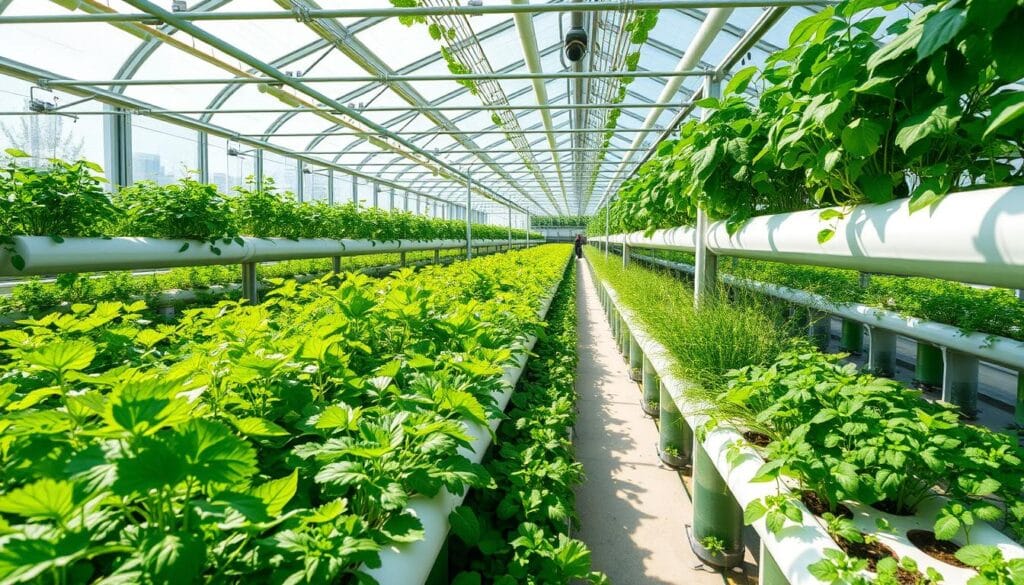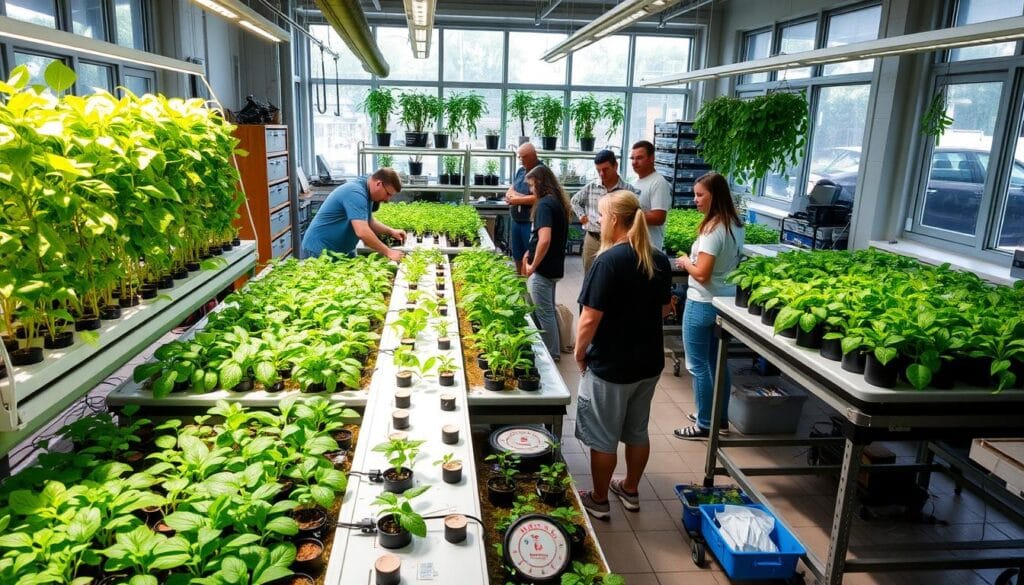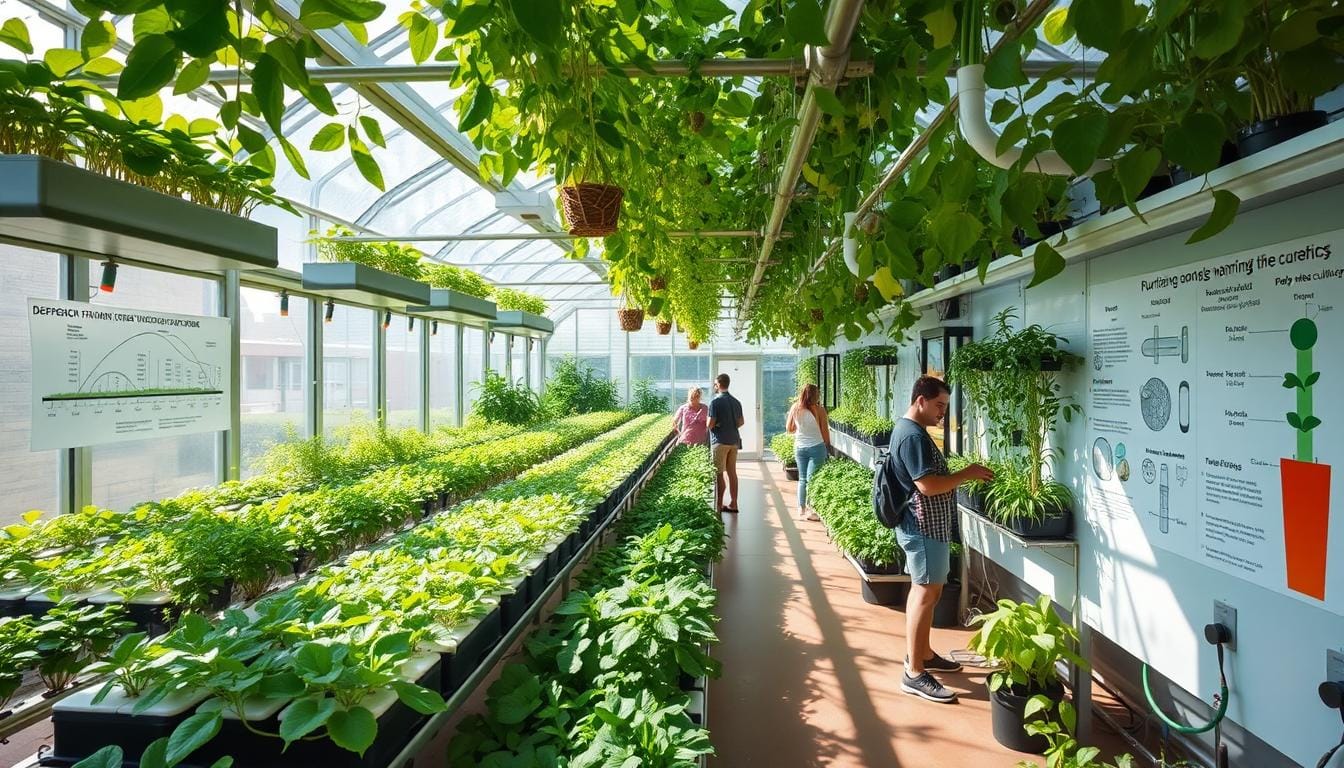Hydroponic Education Programs: The world faces big environmental challenges and a growing need for food. Hydroponics offers a solution. It’s a new way to grow plants without soil. The School of Hydroponics has been leading this change for over 20 years.
They provide detailed training programs. These help people like you learn about hydroponics. It’s a chance to grow food in a new and exciting way.
Hydroponics is becoming more popular in farming. It fights soil diseases, grows plants all year, and uses less space and water. If you’re a farmer, entrepreneur, or just interested in green living, there’s a lot to learn.
Online courses, workshops, and training programs are available. They give you the tools to start your hydroponic journey. You can do it with confidence.
Key Takeaways
- Discover the fundamentals of hydroponic cultivation and its benefits for sustainable food production.
- Explore the diverse range of hydroponic education and training programs available to suit your needs.
- Gain hands-on experience and practical skills for successful hydroponic growing.
- Learn about the latest advancements in hydroponic technologies and their applications in education.
- Uncover career opportunities in the rapidly growing hydroponics industry.
Understanding the Fundamentals of Hydroponic Cultivation
Hydroponic cultivation is a new way to grow plants without soil. Plants grow in water full of nutrients, called soilless crop production training. This method is fast, gives high yields, and uses less water.
Basic Principles of Soilless Growing
Hydroponic systems have key parts that help plants grow well. These include grow lights, systems for nutrients, and controls for the environment. These controls manage temperature, humidity, and CO2 levels.
Essential Components of Hydroponic Systems
- Grow lights to simulate sunlight and promote photosynthesis
- Nutrient delivery systems that continuously supply plants with a balanced mix of essential nutrients
- Environmental control mechanisms to maintain optimal temperature, humidity, and CO2 levels
Water and Nutrient Management
Managing water and nutrients is key for hydroponic systems. Growers must check and adjust the water’s pH, electrical conductivity, and nutrient levels. This ensures plants get the right nutrients for growth.
| Hydroponic Cultivation Principles | Key Considerations |
|---|---|
| Soilless Growing | Nutrient-rich water solutions, no soil required |
| Essential Components | Grow lights, nutrient delivery systems, environmental controls |
| Water and Nutrient Management | Precise monitoring and adjustment of pH, EC, and nutrient levels |
Learning about hydroponic cultivation opens doors to new farming methods. It offers chances for controlled environment agriculture education and soilless crop production training.
Benefits of Modern Hydroponic Farming Methods
Hydroponic farming is changing the game in agriculture. It offers many benefits for both institutions and individuals. These include better space use and water saving, making food production more efficient.
Hydroponic farming is great for using space well. It can grow 45 times more food than traditional farming. This is done using 98% less water and land. It’s perfect for cities or places with little space.
Hydroponic farming also grows plants faster. This means quicker harvests and more food. It also saves water by recycling it. Growers can control nutrients and environment for healthier plants.
Hydroponic systems use less energy with LED lights and climate control. This makes farming more eco-friendly. It’s good for those wanting to lower their carbon footprint.
By using hydroponic greenhouse management programs and vertical farming education, schools can teach sustainability. Hydroponics fits into many subjects like STEM and environmental science. It offers real-world learning experiences.
“Hydroponic farming has the potential to revolutionize the way we approach food production, especially in urban and resource-constrained environments. Its efficiency, sustainability, and educational value make it a game-changer in the agricultural landscape.”
Hydroponic farming is a key solution for global food security and sustainability. It’s efficient, sustainable, and educational. It’s a step towards a brighter, more food-secure future.
Hydroponic Education and Training Programs Overview
In the world of hydroponics, learning is key. It helps new growers and farmers get started. There are many ways to learn about indoor farming and hydroponics.
Certificate Programs and Courses
Many places offer certificate programs in hydroponics. These cover topics like plant science and system design. They are made for all levels, from beginners to experts.
Online vs. In-Person Learning Options
Learning in hydroponics is flexible. You can take online courses or join in-person workshops. Online, like Upstart University, lets you learn at your own pace. Local places offer hands-on learning too.
Duration and Cost Considerations
Programs in hydroponics vary in length and price. Some last weeks or months, while others are just a day. Prices range from free to expensive. It’s important to find a program that fits your budget and needs.
| Program | Duration | Cost |
|---|---|---|
| Hydroponic Cultivation Certificate | 6 modules, 1 hour each | Free for initial offering |
| Hydroponic Farming Workshop | 1.5 hours | Free |
“Hydroponics is the future of farming, and we’re committed to providing accessible education to help individuals and communities embrace this sustainable solution.”
– John Doe, Founder of Levo International
Essential Skills for Successful Hydroponic Growing
To grow plants without soil, you need many skills. You must know a lot about plants, keeping systems running, and controlling the environment. It’s important to understand how to mix nutrients and keep the right pH levels. You also need to watch and adjust the growing conditions closely.
Learning how to care for seedlings, transplant them, and harvest is key. Courses like Flex Farming 101 and the Grow Science Video series are great resources. They offer the knowledge and hands-on tips needed to excel in hydroponics.
“Hydroponic systems promote environmental sustainability through water conservation and reducing the use of pesticides and fertilizers, aligning with the goals of many individuals, such as environmental activist Greta Thunberg, to address climate change issues.”
Starting with soilless crop production training and hydroponic greenhouse management programs is crucial. With hard work and a love for green farming, you can make the most of these new ways to grow. This will help make our world greener and more sustainable.

Comprehensive Curriculum Structure in Hydroponics
Starting a journey in hydroponics means learning a lot about science and techniques. Top educators and training providers offer detailed curriculums. These cover key topics to help future growers succeed in controlled environment agriculture.
Plant Science and Nutrition
Plant science and nutrition are at the heart of hydroponic learning. Students learn about seedling care, transplanting, and harvesting. They also understand the importance of light and water for plant growth.
They study how water and nutrients are delivered to plants. This knowledge helps ensure plants grow well.
System Design and Maintenance
Good hydroponic programs teach about different growing systems. They focus on controlled environment agriculture education and hydroponic education and training programs. Students learn to design and fix hydroponic setups.
This hands-on experience helps them create efficient systems. These systems meet their specific needs.
Environmental Control Techniques
Knowing how to control the environment is key to growing plants well. Hydroponic courses teach about managing temperature, humidity, and light. Students learn how to use smart tools to improve their growing spaces.
By diving into a detailed hydroponic curriculum, learners get a strong base. They’re ready to excel in controlled environment agriculture education and hydroponic education and training programs.
Practical Training and Hands-on Experience
Mastering hydroponic cultivation requires practical training. Leading hydroponic greenhouse management programs and soilless crop production training courses focus on hands-on experience. This lets students dive into the growing process.
Fork Farms offers a unique program with the Flex Farm system. It’s a cutting-edge hydroponic setup. Learners get to set up, maintain, and fix different parts of a working system. These workshops and training sessions offer deep insights into hydroponic cultivation.
Some programs also include internships or partnerships with commercial hydroponic farms. This real-world experience lets students apply what they’ve learned. They sharpen their skills and learn the industry’s top practices.
“The hands-on training was a game-changer for me. I was able to get my hands dirty and truly understand the intricacies of hydroponic systems, from nutrient management to environmental control. It’s an experience I wouldn’t exchange for the world.”
These educational programs mix theory with practical application. They empower future hydroponic experts. With expert guidance and hands-on learning, mastering hydroponic greenhouse management and soilless crop production becomes a rewarding journey.

Advanced Technologies in Hydroponic Education
Hydroponic education is moving forward with new technologies. These programs are getting ready for the future of vertical farming and high-tech greenhouses.
Smart Monitoring Systems
Modern hydroponic growing uses smart monitoring systems. These systems help students keep track of things like temperature, nutrient levels, and plant health. This way, they can make better decisions and improve their growing skills.
Automation and Control Systems
Automation and control systems are changing hydroponic growing. They control things like temperature, humidity, lighting, and nutrient delivery. Students learn to use these systems to make growing more efficient and to increase crop yields.
Data Analysis Tools
Data analysis tools are key in hydroponic education. They help students understand how well their systems are working. By using these tools, they can find ways to improve and make better decisions for growing crops.
By adding these advanced technologies to education, students get ready for the future of farming. They learn to lead in controlled environment agriculture education and vertical farming education.
“The future of agriculture lies in the integration of cutting-edge technologies, and hydroponic education programs are at the forefront of this revolution.”
Career Opportunities in Hydroponics
The hydroponic industry is booming, offering many career paths. If you’ve studied hydroponic education and training programs, you’re set. You can work in commercial farms, research, system design, or even start your own business.
There’s a big need for sustainable farming and local food. This means lots of jobs in hydroponics. You could be a hydroponic engineer, farm manager, agronomist, or technical expert. To succeed, you need to know a lot about plants, nutrients, and indoor farming tech, like indoor farming certification.
To thrive in hydroponics, keep learning and stay current. You’ll need to be flexible, solve problems, and follow rules and green practices. With the right skills and knowledge, you can have a fulfilling career in this fast-growing field.

